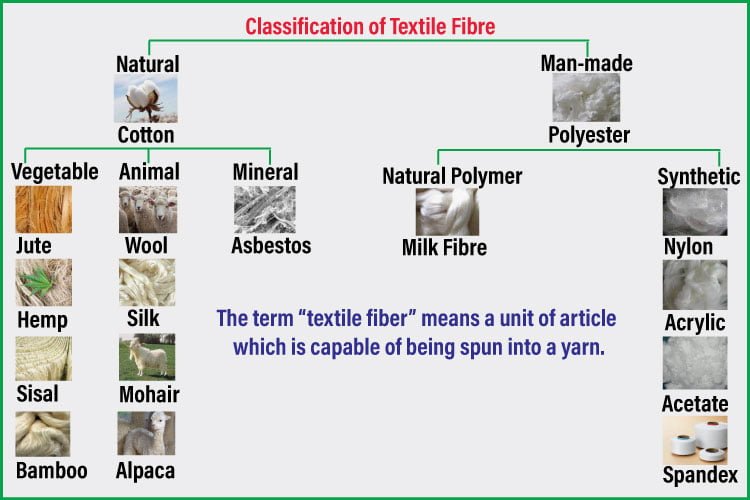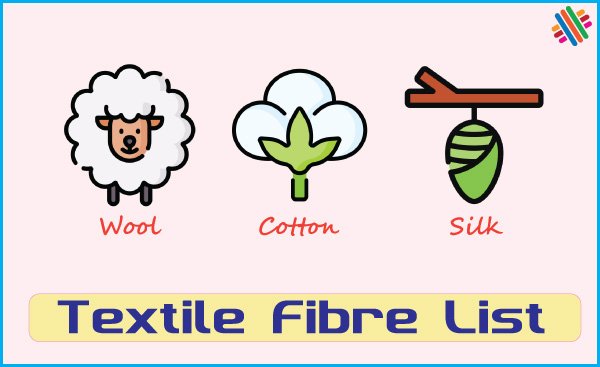Classification of Textile Fibres | Natural & Synthetic Types
Last updated on July 14th, 2025 at 02:00 am
Textile fibres are the raw materials used to make yarns and fabrics. These fabrics then become the clothes we wear every day.
Whether it’s breathable cotton for summer or warm wool for winter, understanding fibre types helps us make smart material choices.
In this guide, you’ll learn how textile fibres are classified, with examples of natural, synthetic, and re-generated fibres used in today’s textile industry.

Classification of Textile Fibres
Textile fibres used in modern fabric manufacturing are broadly classified into two main groups:
- Natural fibres
- Man-made fibres
🌿 Natural Fibres
Natural fibres are those obtained directly from nature in a ready-made fibrous form. Examples include cotton, wool, jute, silk, and flax. These fibres require minimal processing to be converted into yarn and fabric.
Natural fibres are further divided based on their source:
- Vegetable fibres
- Animal fibres
- Mineral fibres
🌱 Vegetable Fibres
These fibres come from plants and are primarily made of cellulose, which plants use for structural support. Key examples include:
- Cotton – the most widely used natural fibre
- Flax – used to produce linen
- Hemp and Jute – common in coarse fabrics and packaging materials
Vegetable fibres are renewable, biodegradable, and widely used in apparel and home textiles.
🐑 Animal Fibres
Animal fibres are derived from hair, fleece, or secretions of animals and are made of proteins. These include:
- Wool – from sheep
- Silk – produced by silkworms as a filament
- Alpaca, Mohair, and Cashmere – from other animals
Animal fibres are known for their warmth, elasticity, and luxurious feel.
🪨 Mineral Fibres
Mineral fibres occur naturally but have limited use in textiles. The most notable is asbestos, used in fireproof and industrial fabrics. Due to health risks, its use is now highly restricted or banned in many countries.
🏭 Man-Made Fibres
Man-made fibres are not found in usable fibrous form in nature. They are created by humans through chemical or mechanical processing. These fibres are categorized into two main types:
- Regenerated or natural polymer fibres
- Synthetic fibres
🌾 Natural Polymer Fibres (Regenerated)
These fibres are made from natural raw materials like cellulose or proteins, which are chemically treated and spun into fibres. The source materials are natural, but the fibre form is man-made.
Examples:
- Viscose Rayon – made from purified cellulose (wood pulp)
- Casein Fibre – made from milk protein
- Azlon – from proteins in soybeans, peanuts, or maize
These are also called regenerated fibres because the base substance exists naturally, but humans modify it into a new form suitable for textiles.
⚗️ Synthetic Fibres
Synthetic fibres are entirely human-made, from the molecular level up. They are produced from petrochemicals such as coal, oil, or natural gas, which are processed into polymers and extruded into fibres.
Common synthetic fibres include:
- Nylon
- Terylene (polyester)
- Orlon (acrylic)
These fibres offer excellent durability, stretch, wrinkle resistance, and moisture-wicking performance. They are widely used in activewear, technical textiles, and home furnishings.
Unlike natural fibres, synthetic ones are engineered for specific properties—making them one of the most versatile and customizable materials in textile manufacturing.
FAQs on Classification of Textile Fibre
What are the two main types of textile fibres?
Textile fibres are classified into natural fibres (like cotton and wool) and man-made fibres (like nylon and polyester).
What’s the difference between natural and synthetic fibres?
Natural fibres come from plants or animals. Synthetic fibres are made from chemicals through human processes, with no natural source.
Which fibre is best for hot weather?
Cotton is ideal for hot weather due to its breathability, softness, and moisture-absorbing properties.
You may also like: Updated Textile Fibre List




One of mineral fiber is Asbestos how it is applicable for fire proof and Industrial fabrics which type of industrial fabric is made from Asbestos.
Does your blog have a contact page? I’m having problems locating it but, I’d like to shoot you an email. I’ve got some recommendations for your blog you might be interested in hearing.
I learned something reading this text, thanks